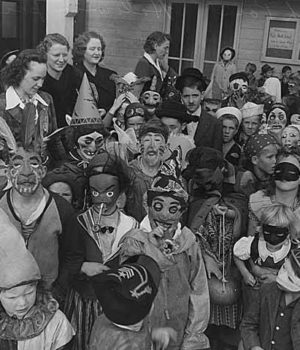Written by Zoe Manoukian
The years of Halloween saw more spooky costumes than witty or current costumes. While today we are likely to imitate a specific person when dressing up, the objective during the 19th century was mostly concerned with concealing identity. Costumes were meant to evoke a sense of death or otherworldliness, and there was no such thing as a premade or box costume. Instead, participators created their own costumes, often dressing as witch or ghoul-like figures.
At the close of the century, “exotic” costumes that portrayed other cultures rose in popularity. There was little to no regard for sensitivity, and many costumes of this time would be considered appropriative or offensive by today’s standards as both children and adults portrayed Chinese men and Egyptian princesses.
By the turn of the century, Halloween was more commonly celebrated among schools and civic societies and became more of a family affair. Costumes at this time were created with the intention of only being worn once, and children often dressed in crepe paper aprons decorated with “haunting” designs of cats and witches and paired with matching paper hats or face masks.
The 1930s saw an increase in attention towards costumes, as concerned parents began to organize activities that we now consider to be traditions, such as haunted houses, trick or treating, and costume parties. As Halloween became more festive and centered more around children than it had in the past, costumes became more kid-friendly and less death-obsessed, and they included characters from radio shows, comics and movies. Mickey Mouse, for instance, was a hit! Box costume sets were even sold by department stores such as Sears.
Box costumes became more affordable in the 50s, and, due to the transition from radio entertainment to television, we began to see a rise in recurring pop-culture inspired costumes. Box princess, mummy and clown costumes were all the rage, as was the controversial Cowboy and Indian costume. Children also imitated beloved characters such as the Little Orphan Annie, Bowinkle and Peter Pan.
The 70s saw the introduction of presidential masks to the holiday, the most famous being Richard Nixon, a costume which became even more popular following the Watergate Scandal. And a guest attended Nixon’s daughter’s Halloween party donning a mask of former president Lyndon B. Johnson!
Also through the 70s and into the 80s we saw a rise in slasher movie inspired costumes, as well as sci fi/fantasy costumes. Think “Star Wars” and “E.T.”
The 90s saw the establishment of store-bought “sexy” costumes, as well as an onslaught of somewhat ironic costumes as people dressed themselves as McDonald’s Happy Meals and Tootsie Pops.
This brings us to today. Now, all of the aforementioned costumes and their sexy counterparts are likely to be purchasable at any Halloween Express or Party City.




